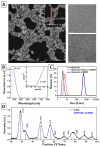Exploring the Long-Term Tissue Accumulation and Excretion of 3 nm Cerium Oxide Nanoparticles after Single Dose Administration
- PMID: 36979013
- PMCID: PMC10045098
- DOI: 10.3390/antiox12030765
Exploring the Long-Term Tissue Accumulation and Excretion of 3 nm Cerium Oxide Nanoparticles after Single Dose Administration
Abstract
Nanoparticle (NP) pharmacokinetics significantly differ from traditional small molecule principles. From this emerges the need to create new tools and concepts to harness their full potential and avoid unnecessary risks. Nanoparticle pharmacokinetics strongly depend on size, shape, surface functionalisation, and aggregation state, influencing their biodistribution, accumulation, transformations, and excretion profile, and hence their efficacy and safety. Today, while NP biodistribution and nanoceria biodistribution have been studied often at short times, their long-term accumulation and excretion have rarely been studied. In this work, 3 nm nanoceria at 5.7 mg/kg of body weight was intravenously administrated in a single dose to healthy mice. Biodistribution was measured in the liver, spleen, kidney, lung, brain, lymph nodes, ovary, bone marrow, urine, and faeces at different time points (1, 9, 30, and 100 days). Biodistribution and urinary and faecal excretion were also studied in rats placed in metabolic cages at shorter times. The similarity of results of different NPs in different models is shown as the heterogeneous nanoceria distribution in organs. After the expectable accumulation in the liver and spleen, the concentration of cerium decays exponentially, accounting for about a 50% excretion of cerium from the body in 100 days. Cerium ions, coming from NP dissolution, are most likely excreted via the urinary tract, and ceria nanoparticles accumulated in the liver are most likely excreted via the hepatobiliary route. In addition, nanoceria looks safe and does not damage the target organs. No weight loss or apathy was observed during the course of the experiments.
Keywords: NP dissolution; NP excretion; NP long-term accumulation; nanoceria; nanoparticle biodistribution; nanopharmacokinetics; nanosafety.
Conflict of interest statement
The authors declare no conflict of interest.
Figures







Similar articles
-
Physiologically based pharmacokinetic modeling of nanoceria systemic distribution in rats suggests dose- and route-dependent biokinetics.Int J Nanomedicine. 2018 May 1;13:2631-2646. doi: 10.2147/IJN.S157210. eCollection 2018. Int J Nanomedicine. 2018. PMID: 29750034 Free PMC article.
-
Quantitative biokinetics over a 28 day period of freshly generated, pristine, 20 nm silver nanoparticle aerosols in healthy adult rats after a single 1½-hour inhalation exposure.Part Fibre Toxicol. 2020 Jun 5;17(1):21. doi: 10.1186/s12989-020-00347-1. Part Fibre Toxicol. 2020. PMID: 32503677 Free PMC article.
-
Distribution, elimination, and biopersistence to 90 days of a systemically introduced 30 nm ceria-engineered nanomaterial in rats.Toxicol Sci. 2012 May;127(1):256-68. doi: 10.1093/toxsci/kfs067. Epub 2012 Feb 23. Toxicol Sci. 2012. PMID: 22367688
-
Ophthalmic Applications of Cerium Oxide Nanoparticles.J Ocul Pharmacol Ther. 2020 Jul/Aug;36(6):376-383. doi: 10.1089/jop.2019.0105. Epub 2019 Dec 5. J Ocul Pharmacol Ther. 2020. PMID: 31891528 Review.
-
Cerium Oxide Nanoparticles (Nanoceria): Hopes in Soft Tissue Engineering.Molecules. 2020 Oct 6;25(19):4559. doi: 10.3390/molecules25194559. Molecules. 2020. PMID: 33036163 Free PMC article. Review.
Cited by
-
Immune Modulation with Oral DNA/RNA Nanoparticles.Pharmaceutics. 2025 May 4;17(5):609. doi: 10.3390/pharmaceutics17050609. Pharmaceutics. 2025. PMID: 40430900 Free PMC article. Review.
-
Emerging Applications of Nanoparticles in the Diagnosis and Treatment of Breast Cancer.J Pers Med. 2024 Jul 4;14(7):723. doi: 10.3390/jpm14070723. J Pers Med. 2024. PMID: 39063977 Free PMC article. Review.
-
Revolutionizing lymph node metastasis imaging: the role of drug delivery systems and future perspectives.J Nanobiotechnology. 2024 Mar 29;22(1):135. doi: 10.1186/s12951-024-02408-5. J Nanobiotechnology. 2024. PMID: 38553735 Free PMC article. Review.
-
Hazard assessment of nanomaterials: how to meet the requirements for (next generation) risk assessment.Part Fibre Toxicol. 2024 Dec 27;21(1):54. doi: 10.1186/s12989-024-00615-4. Part Fibre Toxicol. 2024. PMID: 39725965 Free PMC article.
-
A Brief Review on Cerium Oxide (CeO2NPs)-Based Scaffolds: Recent Advances in Wound Healing Applications.Micromachines (Basel). 2023 Apr 17;14(4):865. doi: 10.3390/mi14040865. Micromachines (Basel). 2023. PMID: 37421098 Free PMC article. Review.
References
-
- Lin J., Huang Z., Liu J., Huang Z., Liu Y., Liu Q., Yang Z., Li R., Wu X., Shi Z., et al. Neuroprotective Effect of Ketone Metabolism on Inhibiting Inflammatory Response by Regulating Macrophage Polarization after Acute Cervical Spinal Cord Injury in Rats. Front. Neurosci. 2020;14:583611. doi: 10.3389/fnins.2020.583611. - DOI - PMC - PubMed
LinkOut - more resources
Full Text Sources
Miscellaneous

